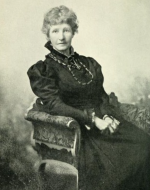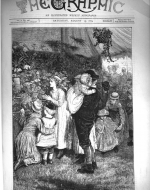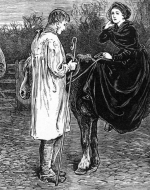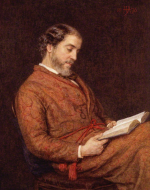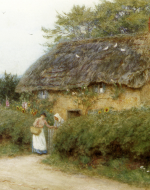Created by Shoshi Cohen on Mon, 03/25/2024 - 17:46
Description:
Fradelle & Young, Photograph of Helen Allingham, 1903, from Happy England as Painted by Helen Allingham, R.W.S., with memoir and description by Marcus B. Huish, L.L.B, 1903, Wikipedia. This exhibition discusses and displays the work of Helen Allingham (1848-1926). Helen Allingham, being an influential illustrator in the Victorian era, has a vivid story behind her art.
Helen Allingham, front page illustration for The Graphic signed H. Paterson, 1874, New York Public Library Archives. Even in her childhood, Helen Allingham had artistic talent when she attended the Birmingham School of Design. At 17 she enrolled at the Female School of Art in London and one year later at the esteemed Royal Academy School. The Royal Academy is an extremely prestigious institution, and in fact, Helen is the niece of the first female student to attend the Academy. During her time at the Academy, Helen worked for engraving firms for income. Through this, her work gained exposure, and she was consequently commissioned for illustrating periodicals and childrens books. So while she was still at school, Helen was hired to illustrate for The Graphic, and became one of the founding staff members, as well as the only woman to be employed at the newspaper at the time. She was a prominent member of the staff, and her illustrations were proudly exhibited just like others’ were. The first image above presents one of her glorious front page illustrations from the fifteenth of August, 1874, signed ‘H. Paterson’, as she was Helen Patterson before she married William Allingham.
Helen Allingham 1874 illustration for Far From the Madding Crowd by Author Thomas Hardy with caption "Do you happen to want a Shepherd, Ma'am?" signed H. Paterson, Wikepedia. Ultimately she terminated her enrollment at the Academy and began working as a full time commercial artist. A well known commission of hers is when she illustrated Thomas Hardy's novel Far From the Madding Crowd. She was the only illustrator hired for Hardy’s book, which was his fourth novel but his first literary success. Whether that was due to Helen's illustrations or the plot (most probably both), the novel certainly displays a joint work of talent that gave it its name. Published on November twenty-thrid 1847, the novel contains twelve illustrations, one of which is included above.
Helen Allingham, Portrait of William Allingham, 1876, Wikepedia Helen enrolled in evening art classes at the Slade School and became good friends with another prominent female artist in London at the time: Kate Greenaway. Through her journey as an artist, Helen was venturing more and more into London’s renowned literary and artistic scene and thus met the man that would become her husband: William Allingham. William is an Irish poet and edited for Fraser's Magazine, a literary journal in London. A watercolor portrait that Helen painted of her husband can be viewed above.
Helen Allingham, A Cottage with Sunflowers at Peaslake, (date not known), Wikepedia. After her marriage, Helen Allingham had no dire need for income so she left her job at The Graphic and fully devoted her time to watercolors–her true passion. Her watercolors began to gain attention and were bought at Academy exhibitions. When the Allingham family moved from London to a more suburban home, Helen’s famed cottage paintings ensued. Due to the railroad expansions, old cottages were being torn down in favor of new homes for the increasing middle class population choosing second homes outside the city. Helen immortalized the history and memory of these cottages by painting a multitude of them–this is part of the reason her cottage paintings came to be so beloved. Another reason is that her paintings contain great detail, so much so that her work is studied by architects to determine the various architectural aspects present in old cottages. A cottage watercolor of hers can be viewed above.
It was a year after her husband's death when she was accepted as a full member to the Royal Watercolor Society. She is the first woman to ever be admitted. Helen also worked with Marcus B. Huish on his book about her, Happy England. Helen Allingham painted up until she died in 1926. She was 78 years old.
It is strikingly evident that Helen Allingham paved much of the way for many women illustrators and artists following her time. She took some of the first steps that were necessary for female success and recognition in respected art society. She herself worked her way up to become one of the most recognized illustrators and watercolor artists of her time. Helen Allingham was an extremely influential and talented woman, and though her memory does not remain as strong as it once was in society, her work should continue to be recognized to have played a significant part in the greater subject of women’s rights.
Bibliography
Martin, Katrina. “Helen Allingham in the Lisa Unger Baskin Collection.” Duke University Libraries, February 9, 2017. https://blogs.library.duke.edu/rubenstein/2016/11/29/helen-allingham-lis....
“Helen Allingham.” Helen Allingham | Art Gallery of NSW. Accessed April 15, 2024. https://www.artgallery.nsw.gov.au/collection/artists/allingham-helen/.
“Helen Allingham R.W.S. (1848-1926).” The Helen Allingham Society. Accessed April 15, 2024. https://www.helenallingham.com/Helen_Biography.htm.
“Helen Paterson Allingham, R. W. S. (1848-1926).” The Victorian Web. Accessed April 15, 2024. https://victorianweb.org/art/illustration/allingham/pva154.html.


